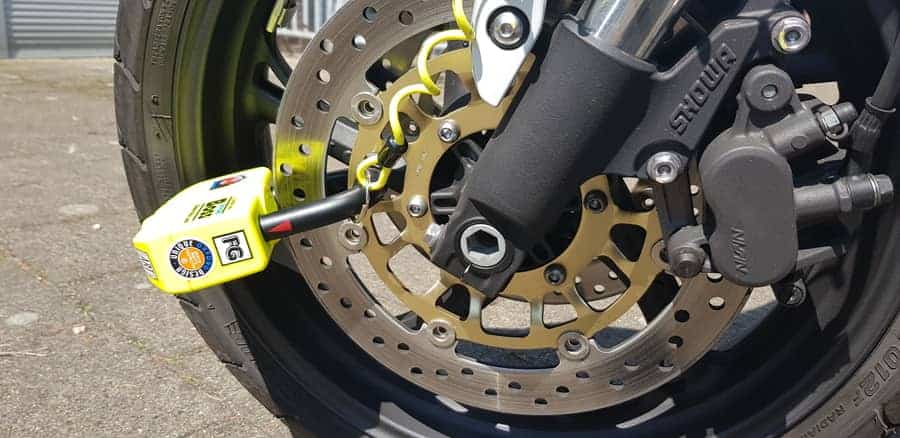Motorcycle theft is a rider’s worst nightmare. Most riders think that it will never happen to them until it does. Fortunately, there are many ways to add a layer or several layers of security to your bike. Bike locks and security systems come in different types, shapes, and sizes depending on what a rider needs.
The best way to secure your motorcycle is by using a chain combined with a secondary lock. The best chain link for your money is the Kryptonite New York Fahgettaboudit Chain.
Tim – Law Enforcement Officer

Check the current price on Amazon (click here)
A lot of riders actually consider the steering lock on their bikes enough deterrence from thieves. The steering lock doesn’t even intimidate thieves one bit. Any idiot with a sharp instrument and a hammer can bypass a steering lock. Some thieves even force the steering loose with brute strength. Want to know more about a thief’s strategy when stealing? You can read about the experiences of an actual thief here.
Motorcycle thieves are opportunistic and they look for low hanging fruit so don’t let your bike be one. Add security to your motorcycle. Don’t rely on your bike’s steering lock. Get a motorcycle lock!
The motorcycle with the weakest lock is the one that gets stolen
The safest way to store a bike is to get a garage and keep the bike hidden. Unfortunately, a lot of us live in places with no garages or in apartment buildings with open parking. A motorcycle lock is a way to go. Locks come in different forms and some can be used when your bike is parked anywhere but some motorcycle security systems are less portable.
Lever lock
A lever lock is a motorcycle lock that attaches to your bike’s handbrake. It keeps the front brake engaged so the bike can’t be rolled away. A lot of riders like this type of lock because it’s easy, simple, and reliable. It’s also easy to remember because you’ll see it right away once you get on your bike. Grip-Lock (check on Amazon) makes a good lever lock that’s light and compact but sturdy.
Personally, I don’t think lever locks are any good. Thieves can just simply cut the brake hose and your bike will be able to roll again.
Disc brake lock
A disc lock can attach to either your front brake disc or rear brake disc. This lock inserts through one of the holes on your disc brake preventing the wheels from turning. A lot of riders also use this because they’re simple and are constructed from high-strength materials. Disc brake locks in the market today, like MYSBIKER’s Alarm Disc Lock and Xena’s XX10 boast that they’re insusceptible to bolt cutters, fire, welding, or freezing. Some disc brakes even have alarms and proximity sensors. I wrote a complete review of my alarmed disk lock, you can read it on this page.
Some riders dislike disc brakes because they tend to forget about them and end up starting to ride with the disc brake on. This usually results in an embarrassing fall and the bike being scratched up. Luckily, some disc brakes now come with a cable or cord that riders can hook onto their brake lever or throttle so they get a reminder.
D-locks
D-locks like the Oxford Boss Alarm Disc Lock (my owner’s review) are basically huge padlocks for motorcycles. A D-lock is a preferred choice for many because of its versatility. A D-lock can attach not only to your disc brake but to any part of the bike. You can have it on the front wheel and disc brake, on the rear brake, on the rear wheel, looped around the chain, hooked to an immovable object and your bike, on your steering, and much more. D-locks also have other uses that we’ll get into later.
Some D-locks also come with alarms and cable reminders and they’re also highly resilient over fire, breakage, freezing, and so on. D-locks are a great and easy way to add security to a bike and seeing a big beefy padlock on a motorcycle might intimidate some motorcycle thieves.
Chain links
A chain link lock like the Kryptonite New York Fahgettaboutit Chain (Amazon) is also a versatile motorcycle lock that can be used in a lot of ways. There’s really not much to a motorcycle chain lock, it’s just a big fat old-fashioned chain link that has added material reinforcement. These chains are not your ordinary chains, however, as they can survive almost anything from heavy-duty bolt cutters to nitrogen freezing spray.
The downside to chain links is that most of them are tough and sturdy but they don’t have any alarms, warning systems, or proximity sensors. But chain links can also be used in virtually any way you want: loop them around your wheels, around the swing arm and the rear wheel, you can even pair two chain links with a D-lock to make a wheel-to-wheel bike lock, or even use them as an anchor attachment.
Anchors
A heavy duty motorcycle anchor is one that requires most work. Motorcycle anchors are designed to be an immovable attachment point for bikes and bike locks. Anchors on their own are useless and are usually paired with chain links or D-locks and can be chained to either of both wheels or as a more secure choice, to the bike’s frame.
Anchors require you to drill a hole or holes in concrete to properly install it. Concrete at least 7 cm in depth is optimal but some anchors have bolts the reach down 15 cm. The Kryptonite Stronghold Anchor (Amazon) mounts three bolts to three-inch deep concrete holes.
Which lock should you get for your bike?
Certainly, we would want to have the safest lock among the many motorcycle locks, right? Well, it’s not as easy as that. None of these locks is technically “safer” than the rest. Each lock provides its own pros and cons.
Some people might think that an anchor lock is safest but you couldn’t really bring it with you. Others say that a disc brake, lever brake, or a D-lock is better because you can bring it anywhere and they provide almost the same level of security as anchors. But motorcycle thieves can just as easily remove the rear or front wheel, whichever wheel your lock is attached to.
The truth is, there’s no single lock to rule them all. Think of motorcycle locks as more of a network of security systems, each providing a layer of security on your bike and together creating a shield.
The best way to lock a motorcycle
There is no definitive “best” way to lock a motorcycle. It depends more on the type of bike you have and where you’re parked. An anchor may sound great but keep in mind that once you install it, it’s there for good. However, there is one thing that a lot of riders will tell you: multiplication is key.
No, I don’t mean arithmetic. Multiply your security by adding more than just one type of lock on your bike. Redundant security is never a bad thing. Yes, it’ll cost you a lot, but not more than a new bike.

Why you should have more than one lock
A lot of riders will tell you that the more locks a bike has, the better. Like mentioned earlier, motorcycles thieves are opportunistic and will opt for the lowest hanging fruit. A motorcycle with one or no security will be their number one target. Put two or more of these locks on your bike and thieves will more likely stay away from it.
• Double, triple, or quadruple the security – More locks just means a bike is more secure, it’s a no-brainer. You can never have too much security, especially when it comes to motorcycles.
• Some thieves able to circumvent most locks – Experience is a great teacher and experienced thieves will learn as they go. They also get creative in how they by-pass modern locks.
• More locks on a bike will make your bike less attractive to thieves – Thieves often go for the easiest catch and if they see a bike that has more security, they will more likely opt to go for an easier bike.
Other ways of securing your bike
Spot trace
What if a motorcycle thief gets all the lock and still gets away with my bike, now what? A Spot Trace GPS unit will help you find your perpetrator. Hide it inside your bike and it’ll send you emails and texts every time your bike moves, plus you can track it on Google Maps. The Spot Trace runs on a satellite plan and works anywhere in the world as long as it’s under the open sky.
Motorcycle cover
This is probably the least secure way of protecting your bike but if the thieves can’t see your bike, they won’t know if it’s worth stealing. Nelson Rigg makes an all-weather motorcycle cover ranging in sizes to accommodate all bikes. Of course, they can always check to see what’s under the cover but if I were a thief and there was an uncovered bike on the next street, I’d probably go for that instead. As the saying goes: “In the wilderness, you don’t have to outrun the bear, you just need to outrun your friends.”
Remove clutch
Forgot your lock and need to leave your bike for a few minutes? Remove the clutch lever! You probably already have a few tools with you and removing the clutch lever just takes five minutes. A clever thief would see that and probably come back with a clutch lever but for a quick temporary thief repellant, this can work.
Better to lock the rear wheel, front wheel is easy to remove
When locking just one of your wheels, go for the rear one. It’s harder to remove. All it takes to remove the front wheel are a couple of bolts but the rear has a lot more going on. It’s not fool-proof, but it’ll still make it harder for most thieves.
